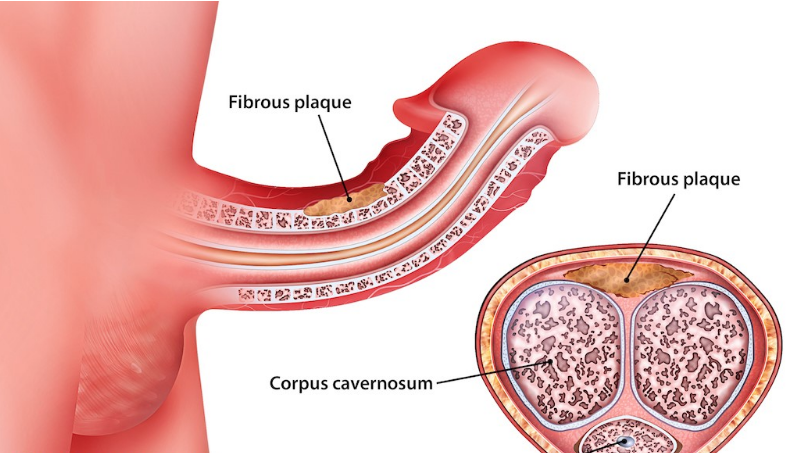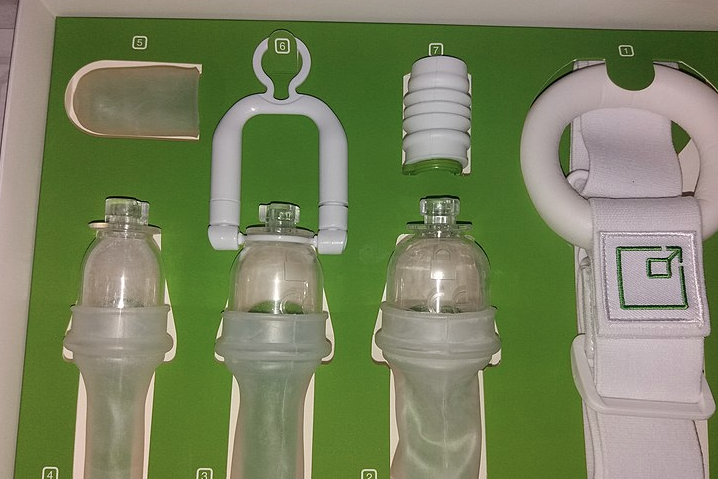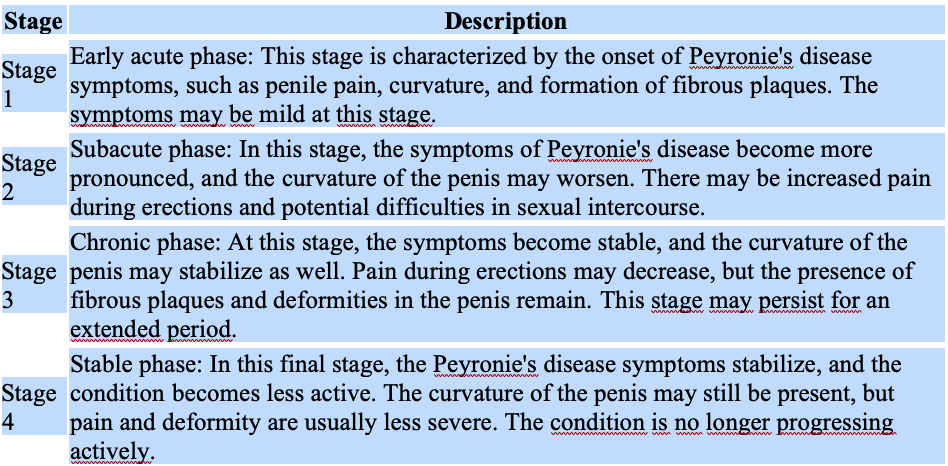
Peyronie’s disease, also known as penile fibrosis, is a noncancerous condition characterized by the formation of fibrous scar tissue on the penis.
This scar tissue can result in painful and often significantly curved erections, leading to challenges in sexual activity and, in some cases, the development of erectile dysfunction.

It’s important to emphasize that variations in penis shape and size are entirely normal; however, Peyronie’s disease can lead to a distressing and pronounced bend, which can be a source of physical and psychological discomfort.
Peyronie’s disease typically doesn’t resolve on its own and may even worsen over time. Early intervention shortly after its onset is key to preventing the condition from progressing and may provide relief from troublesome symptoms.
Even individuals who have been living with Peyronie’s disease for an extended period can explore treatment options to improve their quality of life.
These treatments can address various aspects of the condition, including pain management, reduction of curvature, and addressing concerns like penile shortening.
It’s worth noting that Peyronie’s disease can also have a significant impact on a person’s emotional well-being, often causing stress and anxiety, and managing these psychological aspects is an essential component of comprehensive care.
Peyronie’s disease is thought to result from microtrauma or injury to the penis, which can occur during sexual activity or other activities.
This trauma triggers an inflammatory response, leading to the formation of scar tissue. Over time, this scar tissue can cause the penis to curve when erect, sometimes significantly.
The condition can vary in severity from person to person, with some experiencing only mild curvature and discomfort, while others have more pronounced deformities and severe pain.
The various treatment options include medications, physical therapy, or, in severe cases, surgery. In recent years, traction and vacuum devices have gained recognition as a surgical alternative.

What Causes Peyronie’s Disease?
The exact cause of Peyronie’s disease (PD) is not fully understood, but it is believed to result from a combination of factors. Here are some potential factors that have been associated with the development of Peyronie’s disease:
- Trauma or Injury: Injury or trauma to the penis, such as during sexual activity or certain medical procedures, has been identified as a potential trigger for the development of Peyronie’s disease. This trauma can cause micro-tears or damage to the connective tissues in the penis, leading to scar tissue formation.
- Genetics: There may be a genetic predisposition to Peyronie’s disease, as it can sometimes run in families. Certain gene variations or inherited factors may contribute to an individual’s susceptibility to developing the condition.
- Connective Tissue Disorders: Some individuals with certain connective tissue disorders, such as Dupuytren’s contracture, have a higher risk of developing Peyronie’s disease. These disorders involve abnormal collagen production, which can also affect the connective tissues in the penis.
- Inflammation and Immune Response: Inflammation and an abnormal immune response have been suggested as potential contributors to the development of Peyronie’s disease. It is believed that inflammation in the penile tissues triggers an excessive immune response, leading to the formation of scar tissue.
- Vascular Factors: Impaired blood flow or vascular issues in the penis may also play a role in the development of Peyronie’s disease. Reduced blood flow to the penile tissues can impact their healing and repair processes, potentially leading to abnormal scar tissue formation.
Peyronie’s disease can vary in its presentation and progression from person to person. Multiple factors may interact and contribute to the development of the condition.
What Are The Stages Of Peyronie’s?
Peyronie’s disease is characterized by two distinct stages: acute and chronic.
In the acute stage, which typically lasts for six to 12 months, a scar forms beneath the skin of the penis, leading to curvature or alteration in its shape.
This condition may cause discomfort when the penis is erect or flaccid.
As the disease progresses to the chronic stage, the scar formation ceases, and the curvature does not worsen any further.
Pain usually subsides during this phase, although it may persist, particularly during erections. The chronic phase may also be accompanied by the development of erectile dysfunction (ED).
Here’s a simplified table summarizing the stages of Peyronie’s disease:

The progression of Peyronie’s disease can vary from person to person, and not everyone may experience all stages. Additionally, some individuals may experience a combination of stages, and the severity of symptoms can also differ among individuals.
What Age Do Men Get Peyronie’s Disease?
Peyronie’s disease can affect men of various age groups, but it is most commonly diagnosed in men between the ages of 40 and 60.
However, Peyronie’s disease can occur at any age, including in younger and older individuals, albeit less frequently.
Peyronie’s Disease Symptoms
The most common manifestations include:
- Scar tissue: The presence of scar tissue, known as plaque, can be felt as flat lumps or a band of hard tissue beneath the skin of the penis. It is important to note that this plaque is distinct from the plaque that can accumulate in blood vessels.
- Penile curvature: A significant bend or curve in the penis may occur, either upward, downward, or to one side.
- Erection problems: Peyronie’s disease can contribute to difficulties in achieving or maintaining an erection (erectile dysfunction). However, it is worth mentioning that some individuals report experiencing erectile dysfunction even before the onset of Peyronie’s disease symptoms.
- Penile shortening: The condition can lead to a reduction in the length of the penis.
- Pain: Penile pain, with or without an erection, is a common symptom experienced by individuals with Peyronie’s disease.
- Other penile deformities: Some men may exhibit additional penile deformities, such as narrowing, indentations, or an hourglass-like appearance characterized by a tight, narrow band around the shaft.
The curvature and shortening of the penis associated with Peyronie’s disease may worsen gradually. However, the condition typically stabilizes after three to 12 months.
While pain during erections often improves within one to two years, the scar tissue, penile shortening, and curvature often persist, but in some cases, both the curvature and pain may disappear without treatment.
The development of Peyronie’s disease symptoms can occur rapidly or gradually over time.
If the curvature exceeds 30 degrees, it can result in painful or even impossible sexual intercourse, resembling the position of the hands on an analog clock at 1:00.
Peyronie’s Disease Risk Factors
Risk factors for Peyronie’s disease include:
- Heredity: If a family member has Peyronie’s disease, your risk of developing the condition increases.
- Connective tissue disorders: Men with specific connective tissue disorders, such as Dupuytren’s contracture, are at an elevated risk of Peyronie’s disease.
- Age: Although Peyronie’s disease can affect men of all ages, its prevalence rises with age, particularly among men in their 50s and 60s. Younger men may experience curvature that is often congenital and considered normal.
- Other factors: Certain health conditions, smoking, and certain types of prostate surgery may also be associated with an increased risk of Peyronie’s disease.
Possible complications of Peyronie’s disease encompass:
- Inability to engage in sexual intercourse
- Difficulty in achieving or sustaining an erection (erectile dysfunction)
- Anxiety or stress related to sexual performance or the appearance of the penis
- Strain on your relationship with your sexual partner
- Challenges in fathering a child due to the difficulty or impossibility of intercourse
- Reduced penile length
- Penile pain
What Is The Most Successful Treatment For Peyronie’s?
We discussed in a separate article various treatment options available for Peyronie’s disease.
The effectiveness of treatments for the disease can vary among individuals. Some commonly used treatments include oral medications, penile injections, penile traction therapy, and surgery.
There are at least two effective alternatives to surgical intervention when administered in the early stages of Peyronie’s disease.
The surgical procedure is associated with risks, and specific long-term effects like the recurrence of the disease after years.

